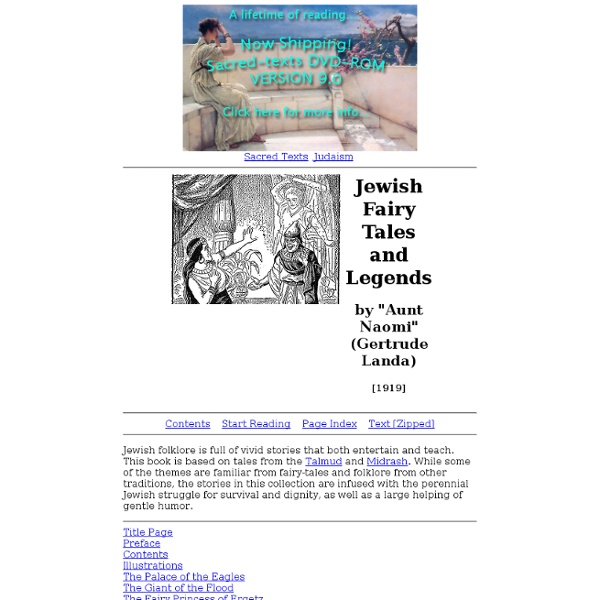



The Standard Prayer Book Contents Start Reading Page Index Text [Zipped] This is a Jewish prayer book, or Siddur, containing prayers, meditations, and texts used during life passage ceremonies including circumcision, marriage and funerals, with variants for Jewish holy days. It includes texts such as the Ten Commandments, the Maimonidean 13 Principles of Faith, and the Pirqe Aboth (Ethics of the Fathers). This Siddur, The Standard Prayer Book, appears to have been widely used in the early 20th century.
Legends of the Jews Sacred Texts Judaism The Legends of the Jews By Louis Ginzberg This is a massive collation of the Haggada--the traditions which have grown up surrounding the Biblical narrative. These stories and bits of layered detail are scattered throughout the Talmud and the Midrash, and other sources, including oral. Volume I: From the Creation to Jacob Title PagePrefaceContentsChapter I: The Creation of the WorldChapter II: AdamChapter III: The Ten GenerationsChapter IV: NoahChapter V: AbrahamChapter VI: Jacob Volume II: From Joseph to the Exodus Title PagePrefaceContentsChapter I: JosephChapter II: The Sons of JacobChapter III: JobChapter IV: Moses in Egypt Volume III: From the Exodus to the Death of Moses Title PagePrefaceContentsChapter IChapter II.Chapter III.Chapter IV.Chapter VChapter VIChapter VII Volume IV: From Joshua to Esther
The Wisdom of Israel Sacred Texts Judaism Wisdom of the East Contents Start Reading Page Index Text [Zipped] This is a short anthology of passages from the Jewish wisdom literature of the Talmud and Midrash, part of the Wisdom of the East series. Unlike some similar compilations, Collins documents where possible the source of his quotations. He also apparently translated from the originals rather than reusing existing English renderings. Title PageContentsEditorial NoteIntroductionWhy God Permits IdolatryThe Lamp that Goes Out when its Light is Done, and the Figs that are Gathered in their Due SeasonThe Labourers in the VineyardThe Likeness of a Palm-TreeThe Tutor and the Naughty PrincelingThose NearestThe Heritage of the Unborn PrinceThe Traveller and the Tree in the DesertBetter Feed the Poor than Entertain the AngelsThe Sand, and the Furnace that PurifiesThe Stars are not envious!
Tanach (JPS) The Jewish Publication Society translation This is the Jewish Publication Society translation of the Tanach, the Hebrew Bible. This etext is a completely new transcription, based on a first edition of the 1917 text, which is under preparation at the Internet Sacred Text Archive and by volunteers. We welcome any reports of typographical errors in this electronic text. Title PagePrefaceThe Law Genesis Exodus Leviticus Numbers Deuteronomy Joshua Judges I Samuel II Samuel I Kings II Kings The Library About Us | Bookstore | Contact Info | Careers | Feedback | Glossary | Links | Publications | Sponsorship Iran Intelligence | Stop-BDS | Joe's Israel | The Israel Calendar Copyright © 2016 American-Israeli Cooperative Enterprise; Webmaster: Jason Levine